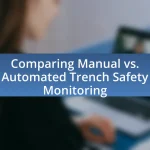Emerging trends in trench safety technologies focus on advanced monitoring systems, enhanced protective equipment, and the integration of artificial intelligence for risk assessment. These innovations, including real-time data analytics and automated shoring solutions, significantly improve worker safety and reduce the risk of trench-related accidents. The article highlights how these technologies address current safety challenges, the importance of staying updated on regulations, and the role of training in effectively implementing new safety measures. Additionally, it discusses the impact of regulatory changes on technology adoption and the best practices for ensuring compliance and safety in trench operations.

What are Emerging Trends in Trench Safety Technologies?
Emerging trends in trench safety technologies include the increased use of advanced monitoring systems, enhanced protective equipment, and the integration of artificial intelligence for risk assessment. Advanced monitoring systems utilize sensors to detect soil movement and environmental changes, providing real-time data to prevent collapses. Enhanced protective equipment, such as lightweight trench boxes and modular shoring systems, improves worker safety and ease of use. The integration of artificial intelligence allows for predictive analytics, helping to identify potential hazards before they occur. These trends are supported by industry reports indicating a significant reduction in trench-related accidents due to the adoption of these technologies.
How are these trends shaping the future of trench safety?
Emerging trends in trench safety technologies are significantly enhancing safety protocols and reducing accidents in excavation work. Innovations such as advanced monitoring systems, including real-time data analytics and sensor technologies, allow for continuous assessment of trench conditions, thereby preventing collapses. For instance, the integration of IoT devices can provide alerts about soil stability and environmental changes, which are critical for maintaining safe working conditions. Additionally, the adoption of automated shoring systems is streamlining the installation process, minimizing human error and exposure to hazards. According to the Occupational Safety and Health Administration (OSHA), proper trench safety measures can reduce fatalities by up to 90%, underscoring the importance of these technological advancements in shaping a safer future for trench work.
What innovations are driving these trends in trench safety technologies?
Innovations driving trends in trench safety technologies include advanced monitoring systems, automated shoring solutions, and enhanced training programs. Advanced monitoring systems utilize real-time data analytics and sensors to detect soil movement and environmental changes, significantly reducing the risk of collapses. Automated shoring solutions, such as hydraulic trench boxes, provide dynamic support that adjusts to soil conditions, improving worker safety. Enhanced training programs leverage virtual reality simulations to prepare workers for real-world scenarios, increasing awareness and adherence to safety protocols. These innovations collectively contribute to a safer working environment in trench operations.
How do these trends address current safety challenges in trench work?
Emerging trends in trench safety technologies, such as advanced monitoring systems and automated excavation equipment, directly address current safety challenges in trench work by enhancing real-time risk assessment and reducing human error. For instance, the implementation of sensors that monitor soil stability and detect hazardous conditions allows for immediate alerts, significantly decreasing the likelihood of collapses, which are a leading cause of fatalities in trench work. Additionally, automated machinery minimizes the need for workers to be in close proximity to potentially dangerous excavation sites, thereby lowering the risk of accidents. These technologies are supported by data indicating that the use of such systems can reduce trench-related incidents by up to 50%, demonstrating their effectiveness in improving safety outcomes.
Why is it important to stay updated on trench safety technologies?
Staying updated on trench safety technologies is crucial for minimizing risks and enhancing worker safety in excavation sites. Advances in technology, such as trench boxes and monitoring systems, significantly reduce the likelihood of accidents, which statistics show are prevalent in the construction industry; for instance, the Occupational Safety and Health Administration (OSHA) reports that trench collapses account for a significant percentage of construction fatalities. By adopting the latest safety technologies, companies can comply with regulations, improve operational efficiency, and ultimately protect their workforce from potential hazards.
What are the potential risks of outdated trench safety practices?
Outdated trench safety practices pose significant risks, including increased likelihood of cave-ins, worker injuries, and fatalities. According to the Occupational Safety and Health Administration (OSHA), trench collapses can occur within seconds, and the risk of a fatality is 1 in 5 when proper safety measures are not implemented. Additionally, outdated practices may fail to address modern equipment and techniques, leading to inadequate protective systems. This lack of adherence to current safety standards can result in legal liabilities and financial losses for companies, as well as long-term health issues for workers exposed to unsafe conditions.
How can new technologies improve compliance with safety regulations?
New technologies can improve compliance with safety regulations by providing real-time monitoring and data analytics that enhance safety oversight. For instance, the use of IoT sensors in trench safety can detect hazardous conditions, such as soil instability or gas leaks, and alert workers immediately, thereby preventing accidents. A study by the National Institute for Occupational Safety and Health (NIOSH) found that integrating wearable technology, like smart helmets equipped with sensors, can significantly reduce workplace injuries by ensuring that safety protocols are followed in real-time. Additionally, software solutions that manage compliance documentation streamline the process, making it easier for companies to adhere to regulations and conduct audits efficiently.

What are the Key Technologies Emerging in Trench Safety?
Key technologies emerging in trench safety include trench boxes, advanced monitoring systems, and drone technology. Trench boxes provide physical protection against collapses, while advanced monitoring systems utilize sensors to detect soil movement and environmental changes, enhancing real-time safety assessments. Drones are increasingly used for site inspections, allowing for aerial views that improve hazard identification and site management. These technologies collectively contribute to reducing accidents and improving compliance with safety regulations in trench operations.
How do advanced monitoring systems enhance trench safety?
Advanced monitoring systems enhance trench safety by providing real-time data on environmental conditions and structural integrity. These systems utilize sensors to detect soil movement, water levels, and gas emissions, allowing for immediate alerts to potential hazards. For instance, a study by the National Institute for Occupational Safety and Health (NIOSH) found that implementing such monitoring technologies can reduce trench-related accidents by up to 50%. This data-driven approach enables proactive measures, ensuring worker safety and compliance with safety regulations.
What types of sensors are commonly used in trench monitoring?
Commonly used sensors in trench monitoring include inclinometers, piezometers, and vibration sensors. Inclinometers measure the angle of slope or tilt in the trench walls, providing critical data on stability. Piezometers monitor groundwater levels and pore water pressure, which are essential for assessing soil conditions. Vibration sensors detect ground movement and potential shifts that could indicate instability. These sensors are integral to ensuring safety and preventing collapses in trench environments.
How do real-time data analytics contribute to trench safety?
Real-time data analytics significantly enhance trench safety by enabling immediate monitoring and response to hazardous conditions. By utilizing sensors and data analytics tools, construction teams can track environmental factors such as soil stability, water levels, and atmospheric conditions in real-time. This proactive approach allows for timely interventions, reducing the risk of accidents and injuries. For instance, a study by the National Institute for Occupational Safety and Health (NIOSH) found that real-time monitoring systems can decrease trench-related fatalities by up to 50% by providing alerts when unsafe conditions arise.
What role do protective systems play in trench safety advancements?
Protective systems are critical in trench safety advancements as they significantly reduce the risk of cave-ins and enhance worker safety. These systems, including trench boxes, shoring, and sloping techniques, provide structural support to prevent soil collapse, which is a leading cause of fatalities in trench work. According to the Occupational Safety and Health Administration (OSHA), proper use of protective systems can decrease the likelihood of accidents by up to 90%. Furthermore, advancements in materials and engineering design have led to more effective and lightweight protective systems, making them easier to deploy and more efficient in safeguarding workers.
What are the latest designs in trench shoring systems?
The latest designs in trench shoring systems include modular aluminum systems, hydraulic shoring, and trench boxes that enhance safety and efficiency. Modular aluminum systems are lightweight and easy to transport, allowing for quick assembly and disassembly on-site, which reduces labor costs and time. Hydraulic shoring systems provide adjustable support, accommodating various trench depths and soil conditions, thereby minimizing the risk of collapse. Trench boxes, designed for deeper excavations, offer robust protection and are often equipped with features like integrated safety rails and access ladders. These advancements reflect a growing emphasis on safety and compliance with updated regulations in trench safety technologies.
How do these protective systems mitigate risks during excavation?
Protective systems mitigate risks during excavation by providing structural support and preventing collapses, which are common hazards in trench work. These systems, such as trench boxes and shoring, stabilize the walls of excavations, reducing the likelihood of soil failure. According to the Occupational Safety and Health Administration (OSHA), proper use of protective systems can decrease the risk of fatalities and injuries associated with trench collapses, which account for approximately 25% of excavation-related deaths. By implementing these technologies, workers are safeguarded against potential hazards, ensuring a safer excavation environment.

How are Regulations Influencing Trench Safety Technologies?
Regulations are significantly influencing trench safety technologies by mandating stricter compliance standards and promoting the adoption of advanced safety measures. For instance, the Occupational Safety and Health Administration (OSHA) has established guidelines that require the use of protective systems, such as trench boxes and shoring, to prevent collapses, which has led to the development of innovative materials and designs in trench safety equipment. Furthermore, these regulations drive manufacturers to enhance technology, such as integrating sensors and monitoring systems that provide real-time data on soil conditions and structural integrity, thereby improving worker safety and reducing accidents.
What are the key regulatory changes impacting trench safety?
Key regulatory changes impacting trench safety include the updated Occupational Safety and Health Administration (OSHA) standards, which emphasize the need for protective systems in trenches deeper than five feet. These regulations mandate that employers conduct soil analysis and implement safety measures such as trench boxes or shoring to prevent collapses. Additionally, recent guidelines have increased training requirements for workers on trench safety protocols, reflecting a growing recognition of the hazards associated with trench work. These changes aim to reduce the incidence of trench-related accidents, which have historically resulted in fatalities and serious injuries.
How do these regulations drive innovation in trench safety technologies?
Regulations drive innovation in trench safety technologies by establishing mandatory safety standards that compel companies to develop advanced solutions. For instance, the Occupational Safety and Health Administration (OSHA) sets specific guidelines for trench safety, which encourages manufacturers to create new equipment such as trench boxes and shoring systems that enhance worker protection. As a result, the need to comply with these regulations fosters research and development in materials and engineering, leading to the introduction of lightweight, durable, and more effective safety technologies. This regulatory pressure not only improves safety outcomes but also stimulates market competition, pushing companies to innovate continuously to meet or exceed compliance requirements.
What compliance challenges do companies face with new regulations?
Companies face significant compliance challenges with new regulations, primarily due to the complexity and rapid evolution of legal requirements. These challenges include the need for continuous monitoring of regulatory changes, which can strain resources and require specialized knowledge to interpret and implement effectively. For instance, the Occupational Safety and Health Administration (OSHA) frequently updates safety standards, necessitating that companies adapt their practices to avoid penalties. Additionally, companies often struggle with the integration of new technologies that comply with regulations while ensuring worker safety, particularly in industries like construction where trench safety is critical. The lack of standardized compliance frameworks further complicates adherence, as companies must navigate varying state and federal regulations.
How can companies effectively implement new trench safety technologies?
Companies can effectively implement new trench safety technologies by conducting thorough training programs for employees, integrating advanced monitoring systems, and adhering to regulatory standards. Training ensures that workers understand the new technologies and their applications, which is crucial for safety compliance. Advanced monitoring systems, such as real-time sensors and data analytics, enhance safety by providing immediate feedback on trench conditions. Furthermore, compliance with regulations, such as those set by the Occupational Safety and Health Administration (OSHA), ensures that the technologies meet safety requirements, thereby reducing the risk of accidents.
What training is necessary for workers to adapt to new technologies?
Workers need comprehensive training in digital literacy, specific software applications, and equipment operation to adapt to new technologies. This training should include hands-on experience with the latest trench safety technologies, such as advanced monitoring systems and automated machinery. Research indicates that organizations that invest in targeted training programs see a 30% increase in productivity and a significant reduction in workplace accidents. For instance, a study by the National Institute for Occupational Safety and Health (NIOSH) highlights that effective training in new technologies leads to improved safety compliance and operational efficiency in trench work environments.
How can organizations measure the effectiveness of new safety technologies?
Organizations can measure the effectiveness of new safety technologies by analyzing key performance indicators (KPIs) such as incident reduction rates, compliance with safety regulations, and employee feedback on technology usability. For instance, a study by the National Institute for Occupational Safety and Health (NIOSH) found that implementing advanced safety technologies led to a 30% decrease in workplace accidents over a two-year period. Additionally, organizations can conduct regular audits and assessments to evaluate the impact of these technologies on overall safety culture and operational efficiency.
What best practices should be followed for trench safety technology adoption?
The best practices for trench safety technology adoption include conducting thorough risk assessments, providing comprehensive training for workers, and utilizing advanced monitoring systems. Risk assessments help identify potential hazards associated with trench work, ensuring that appropriate safety measures are implemented. Comprehensive training equips workers with the necessary skills to operate safety technologies effectively, reducing the likelihood of accidents. Advanced monitoring systems, such as real-time sensors for soil stability and environmental conditions, enhance safety by providing immediate alerts about potential risks. These practices are supported by industry standards, such as those outlined by the Occupational Safety and Health Administration (OSHA), which emphasize the importance of safety protocols in trenching operations.


